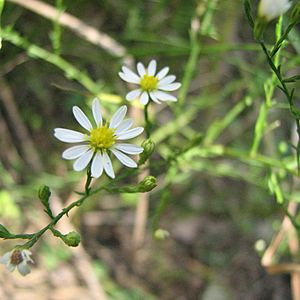Symphyotrichum depauperatum facts for kids
Quick facts for kids Symphyotrichum depauperatum |
|
|---|---|
 |
|
| S. depauperatum from the serpentine grassland demonstration area in Nottingham County Park. | |
| Conservation status | |
| Scientific classification | |
| Synonyms | |
|
The serpentine aster (scientific name: Symphyotrichum depauperatum) is a special and rare type of flower. It has learned to live in a very unusual place called a serpentine barrens. These areas have soil with a lot of natural metals that can be harmful to most plants.
This plant is a perennial herb, which means it lives for more than two years. It can grow up to 50 centimeters (about 20 inches) tall. It usually has one to three stems. Its leaves are thin and about 2–4 centimeters (0.8-1.6 inches) long. The serpentine aster produces many flower heads. These flowers grow in groups, and each one has 7–14 white or pink petals. In the center, there are 7–17 yellow disc flowers.
Where the Serpentine Aster Lives
The serpentine aster mostly grows in special areas in the eastern United States. These areas are called serpentine barrens. There are 26 such places in states like Pennsylvania, Maryland, Virginia, and North Carolina. The serpentine aster can be found in 20 of these unique spots.
Scientists once thought this plant only lived in these serpentine barrens. This is called being endemic. However, it was recently found in another separate area. This new place is in North Carolina on diabase glades, which are also rocky, open areas.
Protecting the Serpentine Aster
The serpentine aster is a threatened species in the state of Pennsylvania. This means it is at risk of disappearing. There are a few reasons why this plant needs our help:
- Limited Homes: It only grows in a few small areas.
- Habitat Loss: Many of the places where it lives are being destroyed. This happens because of quarrying (digging for rocks), building new homes, and creating industrial development (factories or businesses).
Protecting these special areas is very important to keep the serpentine aster safe for the future.


